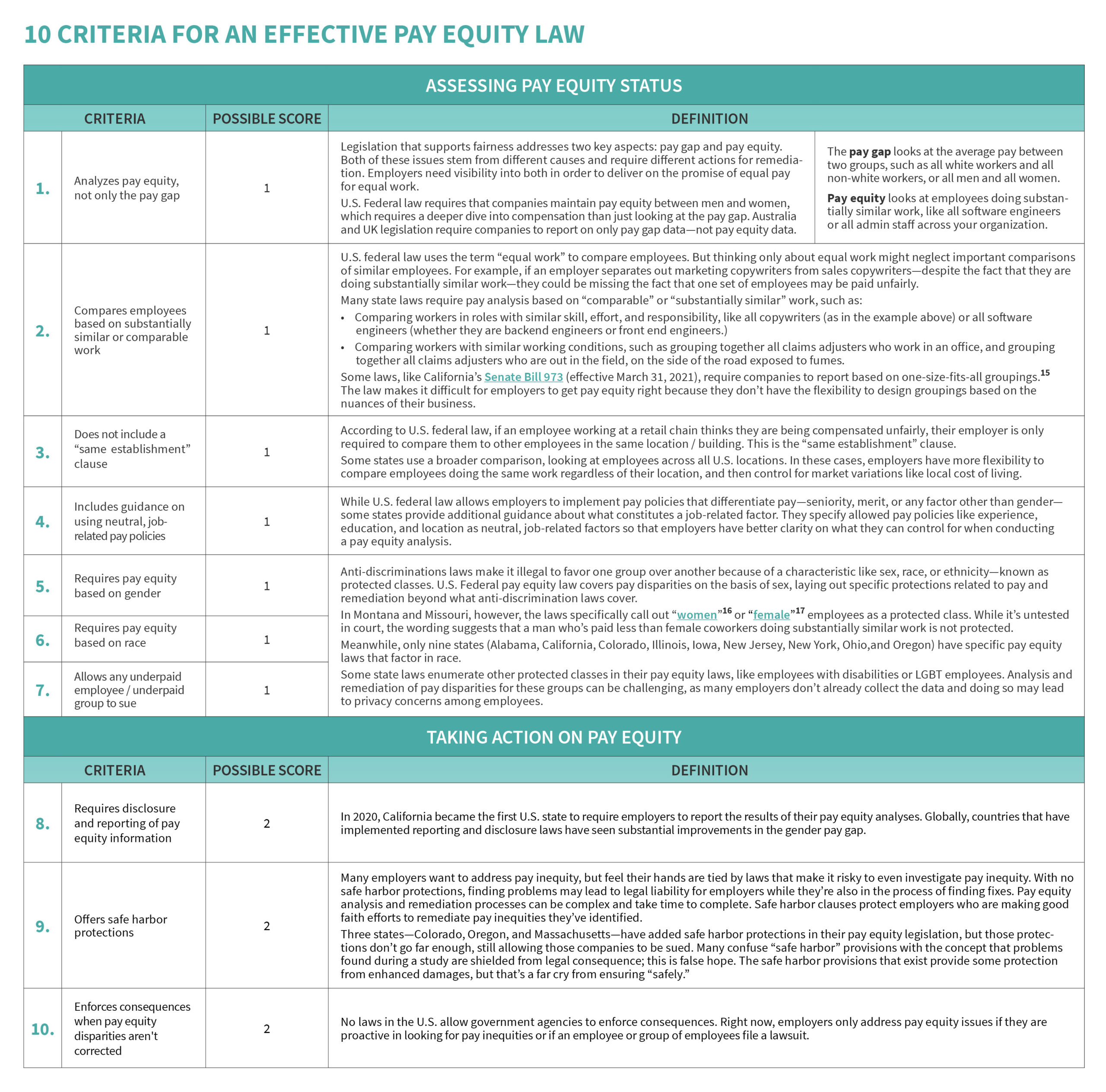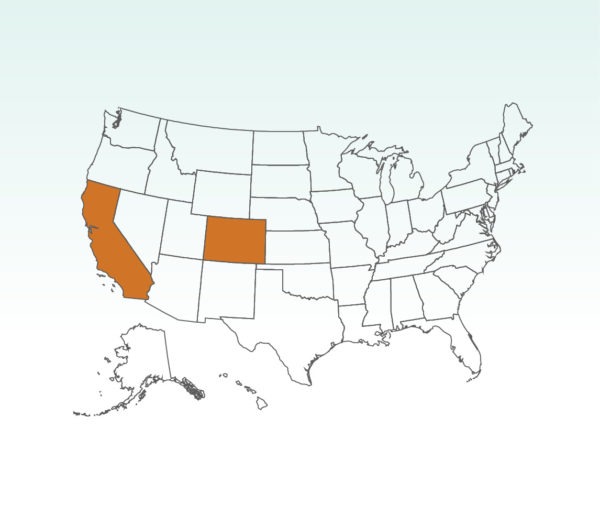The State of Pay Equity Laws in the US — 2021
A comparison of pay equity laws by state — and what needs to change to get the legislation right
Presented by Syndio and Fair Pay Workplace
Executive Summary: The State of Pay Equity Laws in the U.S. — 2021
In the nearly 60 years since the federal Equal Pay Act of 1963 was signed into legislation, 44 states have enacted their own pay equity laws, which in general have been written to incorporate more modern thinking and best practices. However, even the most well-intended laws have put undue burdens on employers, sometimes stymying their ability to make progress on pay equity. And other laws still have flaws that keep them from fully protecting the people who are not being paid fairly.
As pay equity again comes to the forefront of the national conversation and we work to reverse course on the inequities that have been further exacerbated by the pandemic, we’re at a critical moment to get pay equity laws right. And for the first time ever, we have the tools and experience we need to lead the world in achieving it.
In this report, we present the results of a comprehensive analysis of legislation from all 50 states and from other countries to answer several questions. How do pay equity laws compare across the U.S.? How are other countries legislating on pay equity? What makes an effective pay equity law? We also offer our recommendations for improved legislation that actually drives the pay equity outcomes everyone — government officials, CEOs, corporate boards, employees — wants to achieve.
Unlike most legislation, there are few hard choices to make with pay equity laws — they can be written in a way to protect individuals while making it seamless for businesses to comply.
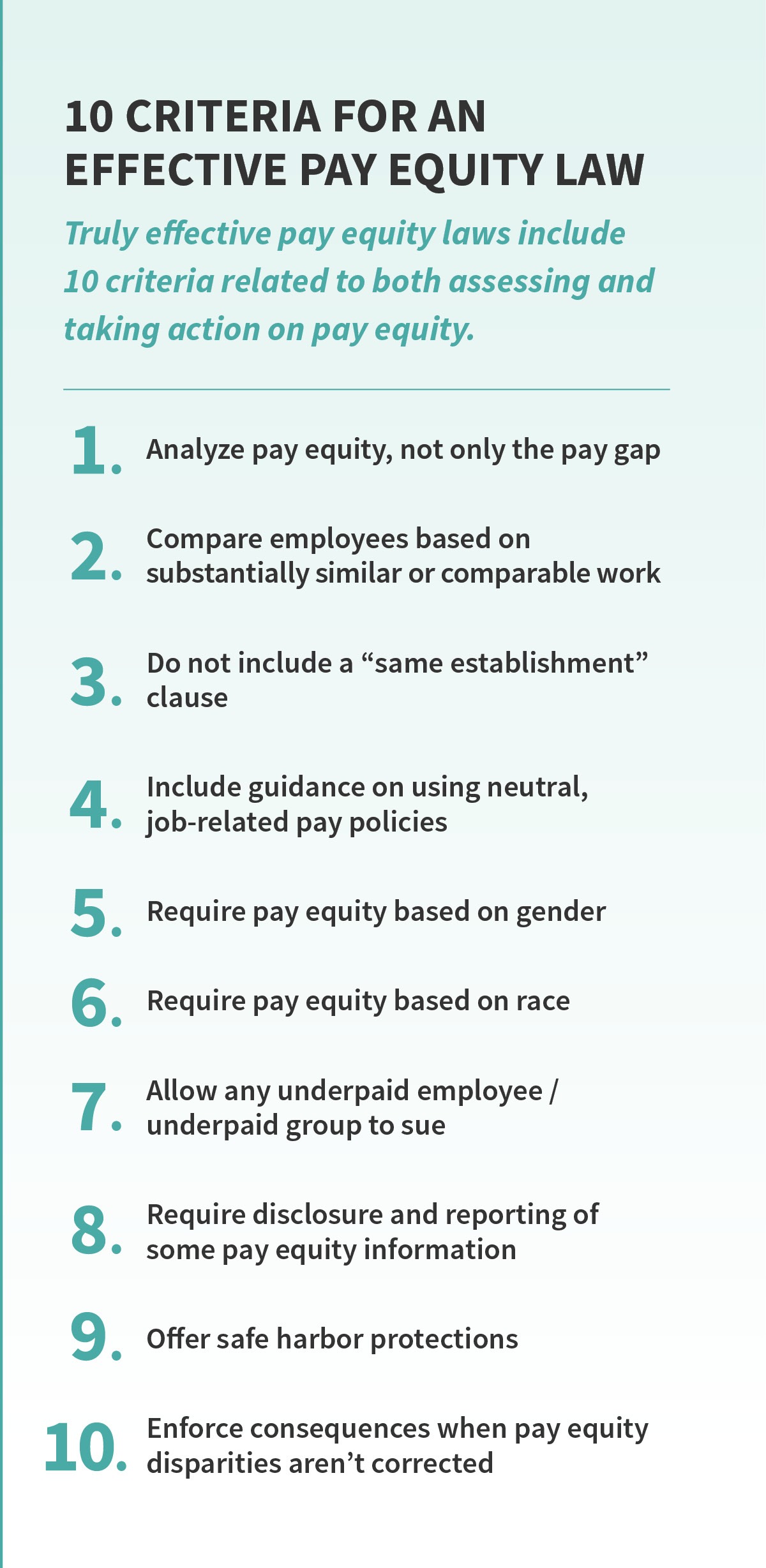
Pay Equity Laws Are Inevitable — How Can the U.S. Get Them Right?
Well before the Covid-19 pandemic began, the World Economic Forum estimated it would take 257 years to close the economic gender gap.¹ We don’t yet know how badly Covid has inflated that number, but we do know the pandemic has sent women away from the workforce in droves, likely reversing progress that’s been made in the last few years. ²
Pay equity isn’t just about gender — it’s about ensuring that people are not paid differently because of their race or ethnicity as well.³ Covid-19 has disproportionately impacted people of color, widening the pay gap and opportunity gap for non-white employees in the U.S.⁴
With the new administration and Democratic Congress, new federal pay equity laws are inevitable, but there need to be some significant changes to what the government has tried in the past. To be effective, pay equity laws must adequately protect individuals and make it feasible for employers to comply.
Even legislation with the best intentions will fail if you’re not considering what will work for employers. Take EEO-1 Component 2, for example, which requires employers to report pay data based on categories (like ‘craft worker’) that may be relevant to some industries (e.g. construction) and irrelevant to others (e.g. technology).⁵ While collecting data in that way may be easier for the government to analyze, it fails to consider how modern businesses operate and collect data, creating a heavy burden for employers. California’s Senate Bill 973 (effective March 31, 2021) repeats this mistake.⁶
As the nation focuses its attention on pay equity legislation, and new proposals like the recently resurrected Paycheck Fairness Act emerge, this is the moment to learn from past mistakes and take steps to get it right.⁷
In this, our first State of Pay Equity Laws report, we present the results of comprehensive analysis of legislation from all 50 states and from other countries to answer several questions. How do pay equity laws compare across the U.S.? How are other countries legislating on pay equity? What makes an effective pay equity law?
Dive in to see what we learned, and our recommendations for improved legislation that actually drives the pay equity outcomes everyone — government officials, CEOs, corporate boards, employees — wants to achieve.
Pay Equity Laws in the U.S.
In the nearly 60 years since the federal Equal Pay Act of 1963 was signed into legislation, 44 states have enacted their own pay equity laws, which in general have been written to incorporate more modern thinking and best practices.⁸ However, even the most well-intended laws have put undue burdens on employers, stifling their ability to make progress on pay equity. And others still have flaws that keep the laws from fully protecting the people who are not being paid fairly.
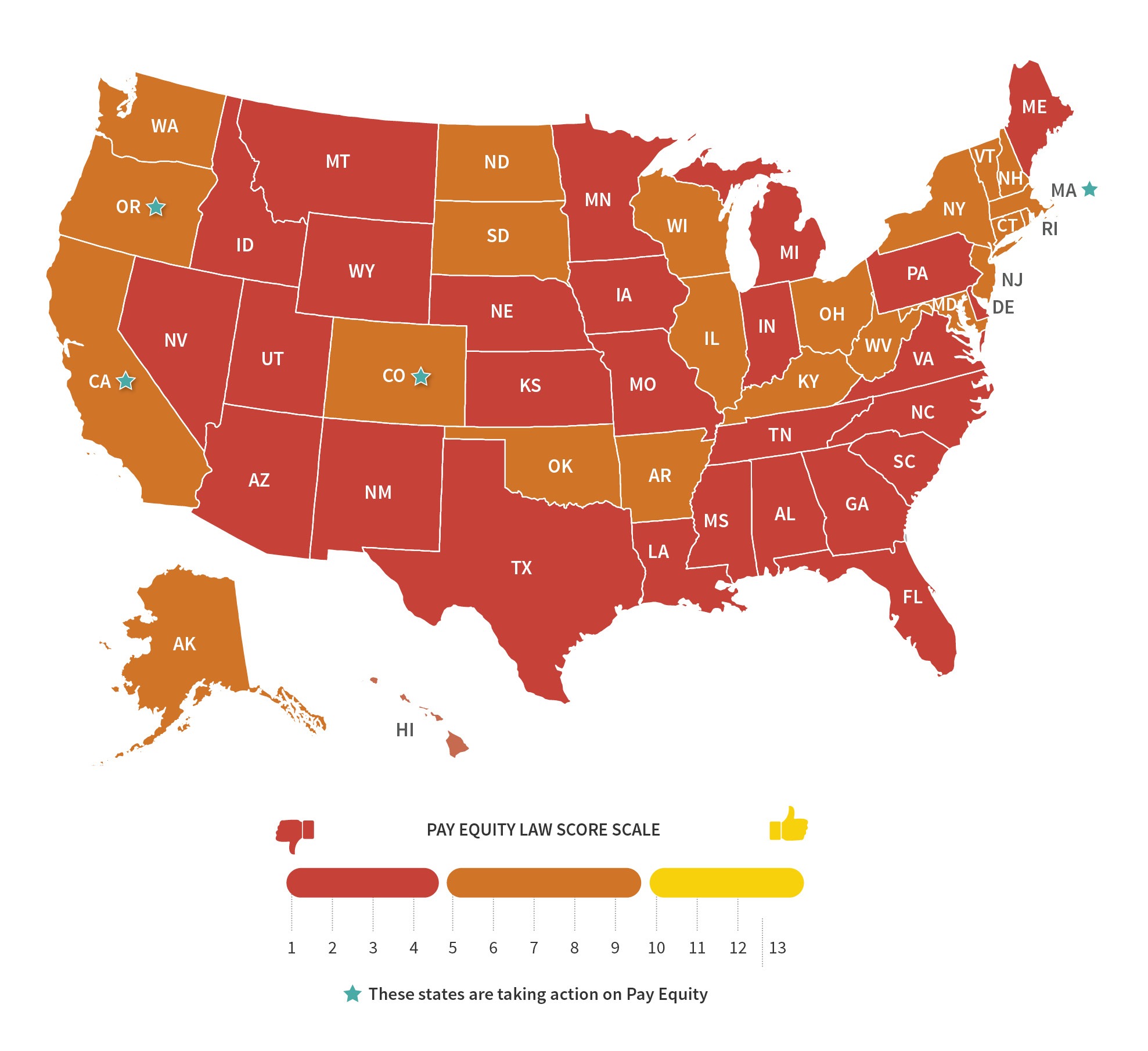
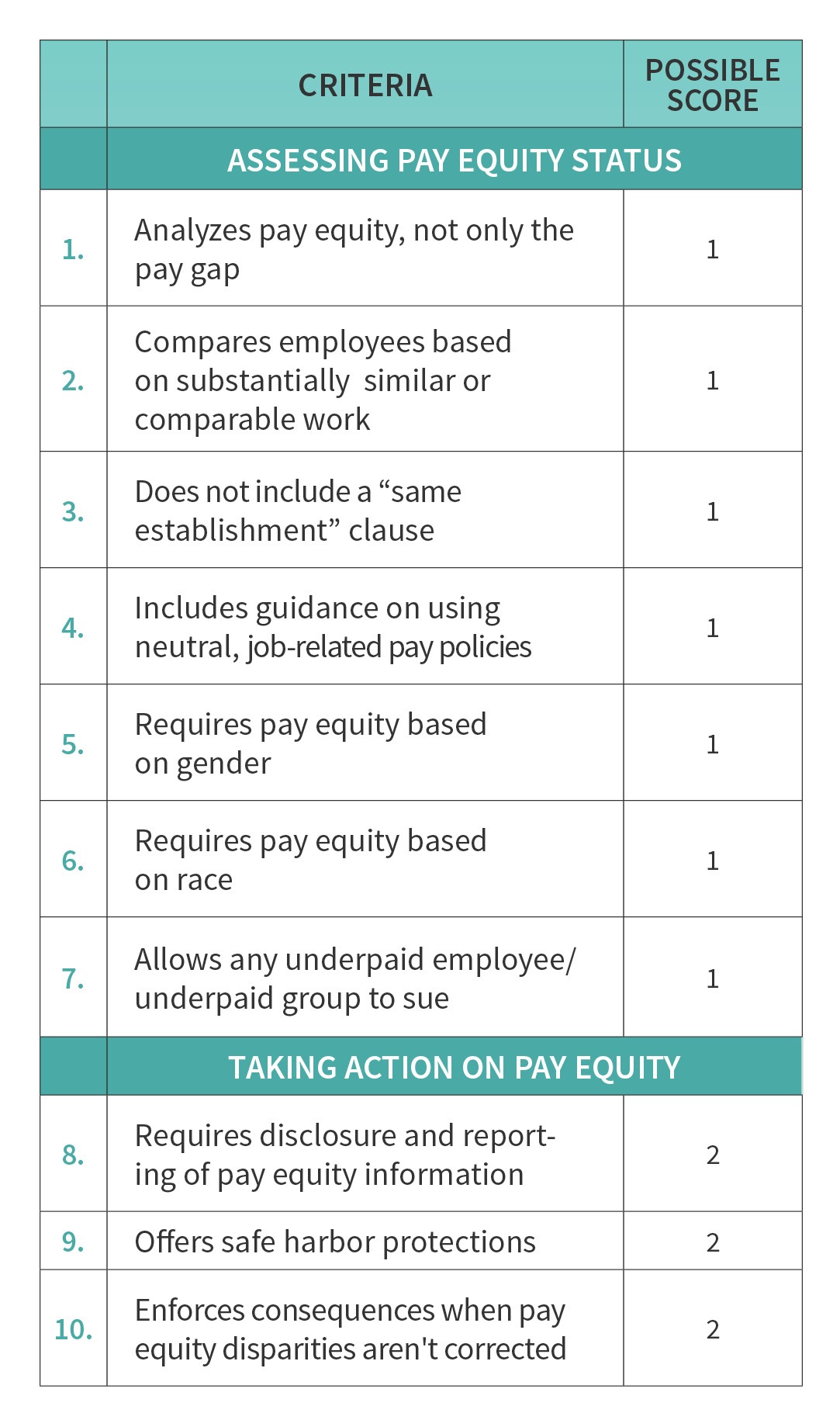
Laws that require employers to assess pay equity is step one — but we're not going to see real change until legislation also supports and motivates employers to take action on those pay equity analysis findings. That's why we assigned one point to each "Assessing pay equity status" criterion, and two points to each "Taking action on pay equity" criterion.
Global Pay Equity Law Examples
Globally, other countries focus legislation on the pay gap — the average pay between two groups, such as all working men and all working women. This is in contrast to the U.S., where laws are focused on pay equity — fair compensation for employees doing substantially similar work.

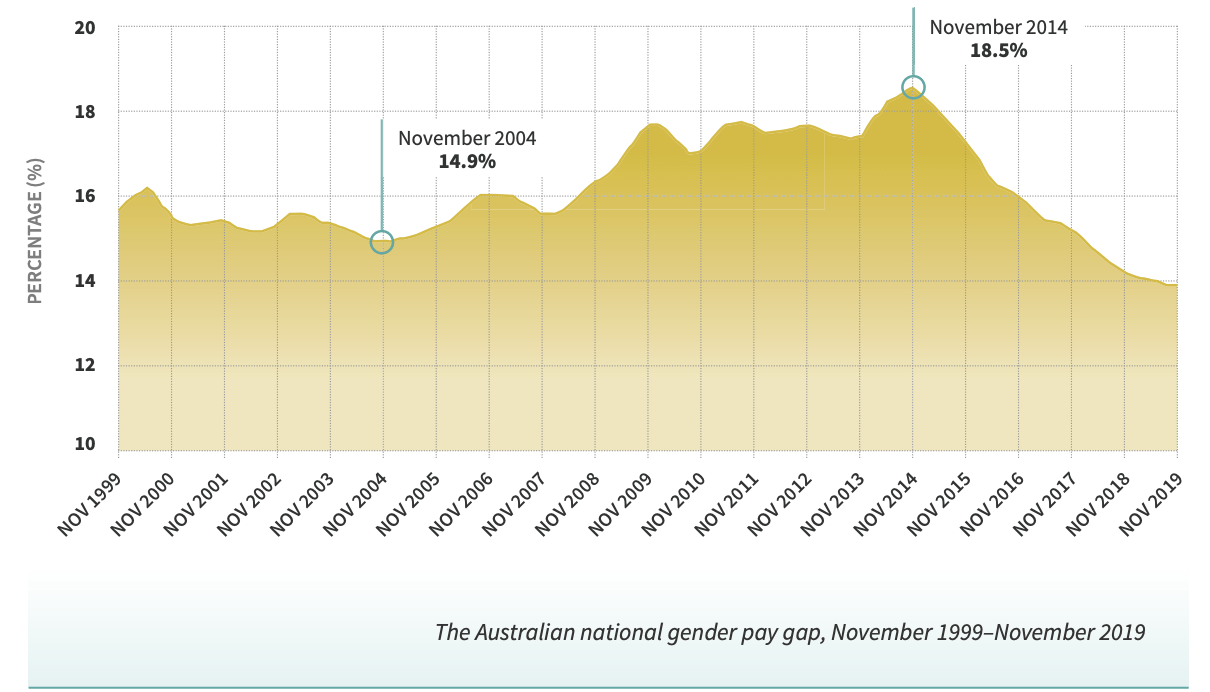



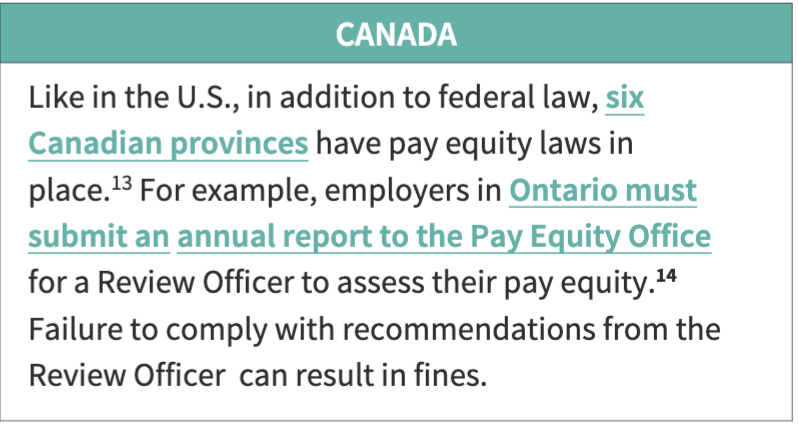
10 Criteria for an Effective Pay Equity Law
Truly effective pay equity requires a balancing of rights: that employers actively and proactively reviewing pay equity not be penalized for doing so; and that employees have adequate laws and access to information to pursue their rights and achieve meaningful remedies. Below, we’ve outlined 10 criteria that optimally balance these rights.
These 10 criteria are the same we used to score each U.S. state above, as they serve as the backbone for an effective pay equity law — one that’s good for employees and good for employers.
New Pay Equity Laws in the U.S.
The 2021 enactment of the California and Colorado laws may be harbingers of improvements in other U.S. states.
In 2021, two states will implement new pay equity laws:
- Colorado’s Senate Bill 19-085 went into effect January 1, 2021.¹⁸ Colorado became the third U.S. state to offer Safe Harbor protections for employers making good faith efforts to fix pay inequities.¹⁹ The law covers both gender and race pay equity and addresses systemic issues of pay equity like salary history.
- With Senate Bill 973 passed in September 2020,²⁰ California is the first state to require reporting.²¹ Employers with at least 100 employees in California must report compensation data for certain job categories by gender, race, and ethnicity to the Department of Fair Employment and Housing (DFEH) and the Division of Labor Standards Enforcement (DLSE) every year, starting on March 31, 2021.
With the Right Laws, Pay Equity Is Within Reach
As pay equity gains steam, it will be important to ensure any new laws protect the rights of individuals and make it feasible for companies to comply. Laws can support both goals, but we’re not going to get there by repeating the mistakes of outdated legislation.
When creating new pay equity laws, legislators need to think like a CEO, not a plaintiff lawyer. Instead of writing laws focused on how a plaintiff lawyer can sue, write them from the perspective of helping employers do the right thing, and remove the hurdles distracting them from achieving pay equity.
For example, effective legislation can de-risk the investigation of pay equity with safe harbors that give employers adequate time and space to fix pay inequities.
Then there’s reporting, which has become more of a distraction from, rather than a driver of, its intended goal — pay equity for every employee. Most U.S. pay equity laws do not require that companies report their data to the government, at least partly because companies push back, claiming an undue burden. And they’re right. The reporting requirements for both EEO-1 Component 2 and California’s new state law are burdensome and bureaucratic.
However, it is possible to write a law that makes it far easier for companies to comply with reporting requirements: ask employers for pay equity data in the way that they maintain their data and that reflects how they actually pay their employees. This step alone will lead to legislation that drives pay equity progress in the U.S.
For corporate leaders, pay equity doesn’t have to be a liability that lives in the shadows. It can be a strength that advances workplace fairness and their employer brand. There are many ways today to identify and fix pay inequities, with technology making it a faster, more easily replicable process.
As pay equity again comes to the forefront of the national conversation and we work to reverse course on the inequities that have been further exacerbated by the pandemic, we’re at a critical moment to get pay equity laws right. And for the first time ever, we have the tools and experience we need to lead the world in achieving it.
The most tangible action that companies can take to undo the negative impacts of systemic racism in the workplace is to create pay equity — fair compensation for employees doing substantially similar work, particularly a traditionally advantaged group like white employees to a minority group like Black employees.
THE STATE OF PAY EQUITY LAWS IN THE U.S. — 2021 REPORT
is presented by Fair Pay Workplace and Syndio.
Fair Pay Workplace is a nonprofit that certifies organizations that comply with a set of pay equity rules and standards set forth by an alliance of experts, and advances the interest of promoting fairness and justice in the workplace.
- World Economic Forum, Closing the Gender Gap Accelerators. Available at https://www.weforum.org/projects/ closing-the-gender-gap-accelerators
- Catalyst, The Detrimental Impact of Covid-19 on Gender and Racial Equality: Quick Take (December 8, 2020) Available at https://www.catalyst.org/research/covid-effect-gender-racial-equality/
- Syndio, Focus on Transparency and Accountability to Fix Racial Pay Inequities (November, 2020) Available at https://f.hubspotusercontent00.net/hubfs/7295757/Syndio%20Race%20White%20Paper.pdf
- Economic Policy Institute, Black workers face two of the most lethal preexisting conditions for coronavirus — racism and economic inequality (June 1, 2020) Available at https://www.epi.org/publication/black-workerscovid/
- HR Dive, EEOC to open 2019, 2020 EEO-1 data collection in April (January 14, 2021) Available at https://www. hrdive.com/news/eeoc-to-open-2019-2020-eeo-1-data-collection-in-april/593398/
- California Legislative Information, Senate Bill No. 973. Available at https://leginfo.legislature.ca.gov/faces/ billNavClient.xhtml?bill_id=201920200SB973
- U.S. Senator Patty Murray, Senator Murray Leads Every Democratic Member of Congress in Re-introducing Bipartisan Paycheck Fairness Act (January 28, 2021) Available at https://www.murray.senate.gov/public/index. cfm/newsreleases?ID=5E40947E-C5E9-4AD6-B530-9F5320841E53
- US Equal Employment Opportunity Commission, The Equal Pay Act of 1963. Available at https://www.eeoc.gov/tatutes/equal-pay-act-1963
- Fair Work Ombudsman, Australia Government, Gender Pay Equity. Available at https://www.fairwork.gov.au/ how-we-will-help/templates-and-guides/best-practice-guides/gender-pay-equity
- Workplace Gender Equality Agency, Australian Government, Australia’s Gender Pay Gap Statistics 2020 (August 17, 2020) Available at https://www.wgea.gov.au/publications/australias-gender-pay-gap-statistics
- The National Law Review, In France, Measuring Wage Inequality Between Women and Men Has Become Legally Required (October 18, 2019) Available at https://www.natlawreview.com/article/france-measuring-wage-in equality-between-women-and-men-has-become-legally-required
- Office for National Statistics, Gender pay gap in the UK: 2020 (November 3, 2020) Available at https://www.ons.gov.uk/employmentandlabourmarket/people
inwork/earningsandworkinghours/bulletins/genderpaygap intheuk/2020 - Pay Equity Commission, Ontario, An Overview of Pay Equity in Various Canadian Jurisdictions 2018. Available at http://www.payequity.gov.on.ca/en/GWG/Pages/overview_pe.aspx
- Pay Equity Commission, Ontario, Enforcement and Complaints. Available at http://www.payequity.gov.on.ca/ en/tools/Pages/guide_to_act13.aspx
- California Legislative Information, Senate Bill No. 973. Available at https://leginfo.legislature.ca.gov/faces/bill NavClient.xhtml?bill_id=201920200SB973
- Montana State Legislature, Montana Code Annotated 2013. Available at https://leg.mt.gov/bills/2013/ mca/39/3/39-3-104.htm
- Missouri Revisor of Statutes, Title XVIII Labor and Industrial Relations. Available at https://revisor.mo.gov/ main/OneSection.aspx?section=290.410&bid=15328&hl=
- 18 Colorado General Assembly, Senate Bill 19-085. Available at https://leg.colorado.gov/sites/default/ files/2019a_085_signed.pdf
- Syndio, Colorado’s Equal Pay for Equal Work Act — What Employers Need to Know (January 11, 2021) Available at https://synd.io/blog_post/colorados-equal-pay-for-equal-work-act-what-employers-need-to-know/
- California Legislative Information, Senate Bill No. 973. Available at https://leginfo.legislature.ca.gov/faces/bill NavClient.xhtml?bill_id=201920200SB973
- Syndio, Is California’s New Law a Step Towards Lasting Fair Pay? (September 18, 2020) Available at https:// synd.io/blog_post/is-californias-new-law-a-step-towards-lasting-fair-pay/
About Syndio
Syndio's mission is to empower employers to eradicate unlawful pay disparities due to gender, race, and ethnicity and make ongoing compensation decisions informed by fairness and equity data. Syndio customers drastically reduce legal risk, saving millions in ongoing remediation and create a positive brand reputation, which helps attract and retain top talent at every level of the business. Syndio is proud to partner with brands who are leading the way in equity and setting the standard for workplace fairness.

